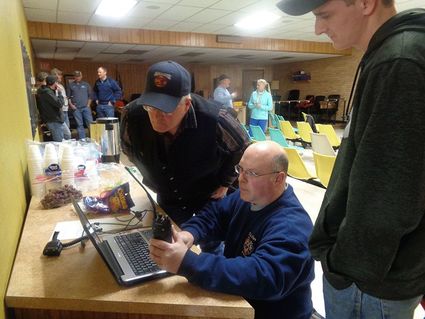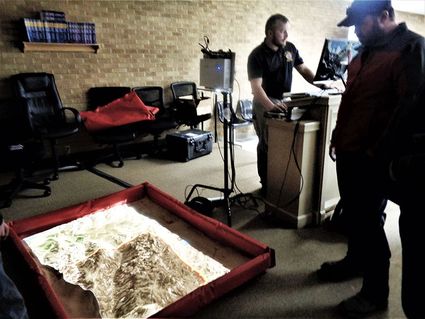45 local volunteer firefighters attend 2nd Annual Northcentral Wildland Fire Training Conference
January 24, 2018

Scott Gallus, Chinook's Assistant Fire Chief, works with two volunteer firefighters from Manchester to program a radio used in firefighting. Gallus presented during the recent Northcentral Montana Wildland Fire Training Conference about the availability of emergency radio frequencies in Montana. The two day training program for volunteer firefighters was organized by Montana DNRC and supported by other emergency and firefighting agencies.
About 45 area volunteer firefighters attended the second annual Northcentral Wildland Fire Training Conference hosted by the Montana Department of Natural Resources (DNRC) in cooperation with several local fire departments and emergency service providers. The training program was designed so volunteers could balance training time with other demands in their personal lives.
Don Pyrah, Fire Management Officer for the DNRC's Northeast Land Office in Lewistown, said, "We first offered a class with this format last year in Glasgow. We made some modifications for this year's class based on input from students that attended the first sessions. Over two days participants can select from several topics. They can attend all the sessions or, if limited by time, they can chose the topic or topics that best fit their schedule and perceived fire training needs."
Providing wildland fire training
is part of DNRC's mission
A number of changes were made in the organization of state government in 1971. At that time the DNRC was created to "Protect lives, property and natural resources on state and private lands," Pyrah explained, "Our (NE Lands Office) part of the mission is to help with fire protection in a 13-county area of northeast Montana. Through the Co-op program we help counties upgrade their fire equipment and provide training to firefighters. When invited, we help fight wildfires (like the East Fork Fire) and can provide technical assistance for fire prevention and fire protection and offer organizational assistance to rural fire departments.
The NE Lands Office assists in a triangle-shaped area from east Hill County to the North Dakota line and south to Harlowton and back to the state line along the Missouri River corridor. Most of the firefighters at the class in Havre were from Hill and Blaine Counties. Blaine County volunteers were from departments in Chinook, Fort Belknap and Lodge Pole.
"Wildfires aren't like they used to be"
In opening remarks DNRC's Don Pyrah noted that 2017 was an especially challenging wildland fire season both nationwide and in Montana. He said, "Wildfires aren't like they used to be. The fires are bigger, involve more firefighting resources and are more expensive to suppress." Nationwide there were 66,000 wildfires in 2017. That's about 4,000 less than normal but the acreage burned was 10 million as opposed to an average year at 6.5 million acres burned. In Montana a million acres burned in 2017 and the cost was $70 million to suppress the fires in the state.
Pyrah said that another significant difference in 2017 was the "widespread nature of the fires in Montana." He explained that during a typical wildfire season in Montana activity would tend to be more serious in either the west or east part of the state. "That," he said, "meant we could move equipment back and forth as needed. This year we didn't have the luxury of sharing equipment because major fires were burning in both east and west Montana."
Training topics were modified by experiences from the East Fork Fire
While the two day format was in place from the first class held last year, Pyrah said, "The topics and content for this class were influenced by challenges we faced during the East Fork Fire in Blaine and Hill Counties." Most of the topics came from 'after action reviews' of the East Fork Fire. "Our emphasis," he added, "was to focus on the 'what and why' a problem occurred and not the 'who.'" Training topics included weather effects on a fire, fire line communications and tactics and fire line leadership and incident command.
A major underlying challenge of the East Fork Fire was its size. One volunteer firefighter, from Inverness, said, "I've been a volunteer firefighter for 20 years and I've never seen anything like that fire. Our firefighters are more familiar with grass fires and usually on a fairly limited scale. We seldom deal with really large fires or fires involving timber." Others noted the challenges of communicating among many firefighters and difficulties creating, distributing and following a plan that was understood by everyone involved. Those challenges were covered in much of the recent training.
A class on communications covered the various frequencies used by fire and emergency agenices in Montana. For the most part the ability to communicate among different volunteer units and governmental units is available through existing communications equipment. Often it's a lack of proper programming of radios or a misunderstanding of which frequencies are being used in a large event, like the East Fork Fire, that causes confusion.
One solution discussed in each session was the need for every arriving resource to be briefed at a staging area before beginning work on a fire. Fire departments were encouraged to do a briefing before "even starting to suppress a hay bale fire." The goal is to get everyone working on an understood set of objectives no matter the size of the fire.
Another theme in all the training had to do with the necessity of a clearly understood incident command structure. Using a sophisticated version of a sand table training aid, firefighters watched as a fire developed in the model. The ability to overview a simulated fire gave participants in the class an opportunity to understand why an incident command structure is so important. "And," as one instructor put it, "why it's important that an overall command is planning where resources need to be as much as three days in advance of the current situation."
The combination of the ability for all resources to be able to communicate with each other, a set of shared objectives to suppress a fire and a chain of command to coordinate all the resources was affirmed in every class. Whether sharing the latest weather forecast or incorporating arriving firefighting resources to suppress a fire, communication was the key. And starting with a briefing, even for a few minutes, was critical to everyone understanding and sharing a common set of goals to control a fire.
What's next?
DNRC personnel will be bringing a four hour program entitled "Fighting Fire for Your Neighbors" to the Bear Paw School (on Clear Creek Road) sometime this winter. The DNRC's Don Pyrah said, "The class is designed for people with no fire fighting training or experience who want to know how to work with volunteer departments on rural fires." A similar class was held in the Cleveland area and fire officials said it has helped everyone responding to a fire to better understand how they can safely help suppress a fire. The exact dates of the class have not been set but will likely be in early February.
Asked for a prediction about the upcoming fire season, Don Pryah said, "It would be okay with me if it rained the entire summer." Likely a sentiment currently shared by a lot of wildland firefighters around Montana and the nation.



